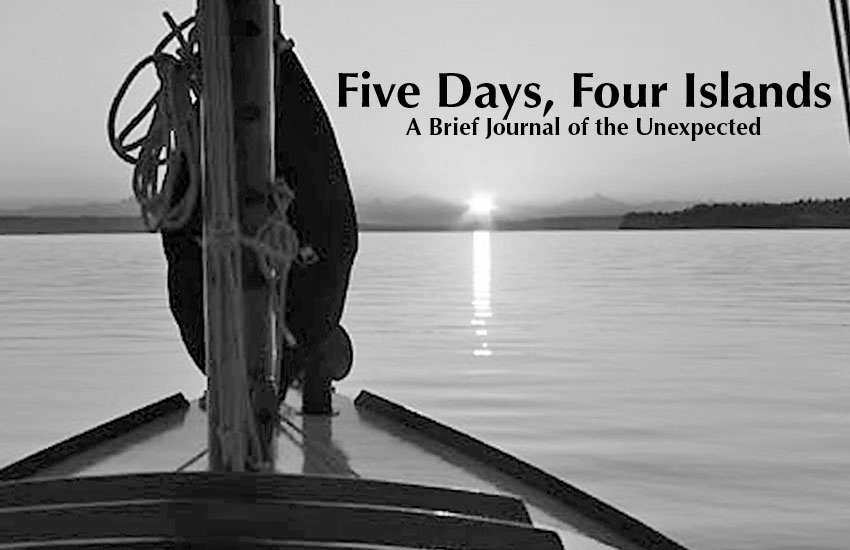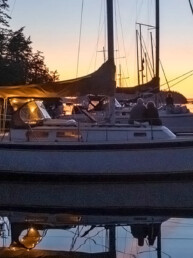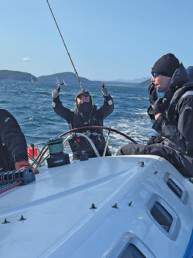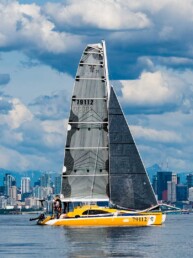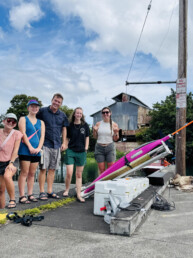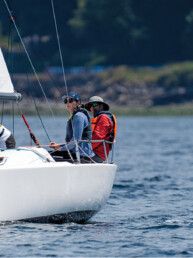In our latest Throwback Thursday, we follow along on a sailing journey through the San Juan Islands where every day and moment must be savored.
“Five Days, Four Islands” first appeared in the April 2004 issue of 48° North
A shortened schedule fosters a new resolve. “Carpe dies omnes quinque.” Seize all five days.
Five days, that was it. The news of an abbreviated autumn cruise was utterly depressing. I felt like a kid who had just been told to strike everything off of his Christmas wish list except that new pair of gym socks.
Last August I was still anticipating three weeks aboard Nais, my aging but doughty Folkboat. Three glorious weeks alone to leisurely cast about the pristine waters of the San Juan Islands. Three weeks. That’s an eternity for a father of three young children. Why, with three weeks I could even sail to another country – Canada, for instance! I could single-hand to Victoria and breath the exotic airs of a foreign land, or at the very least, get good Napoleon at Murchies. Perhaps, beyond all hope, I might even spy a pod of Orcas off of Lime Kiln Point. Ever since my first churny crossing on one of those jammed tour boats, I have dreamt of sailing my own little boat silently into a majestic pod of orcas.
But there seemed scant hope of seeing orcas now or much of anything else for that matter. The news was crushing. “Five days in the last week of September,” my wife Deborah had announced. She said this in a matter-of-fact tone that sounded for all the world as if it posed no greater existential crisis then the choice between paper or plastic. “With the camping trip we promised the kids and the cousins’ surprise visit,” she informed me, “five days is the best we can do.” I hung my head like a seasick basset hound, a melancholy spreading like a dismal, damp fog over the harbor.
Having a predilection to dwell upon the disconsolate, I did what any similarly stouthearted sailor would do: I sulked. It’s not that I begrudged the fact that my family needed me; I did, in fact, count myself as inordinately lucky. But I brooded privately, nonetheless. During this state of bleak torpor I would wander down to the Nais at her moorings, lamenting the fact that she was all but ready for an extended voyage: extra fuel on board, a newly installed battery so that the old girl had running lights for the first time in her long life, the radar reflector hung, water and food neatly stowed away, my first edition of Steinbeck’s “Cannery Row” at the ready on the bookshelf and a glistening new coat of varnish that wrapped the rich iroko topsides. All dressed up, she was, with almost nowhere to go.
Truly I was a pathetic sight. Yet even as I sat glumly in Nais’ broad cockpit, hand on the stayed ash tiller, I felt a deep stirring. It is, after all, virtually impossible to step aboard an able wooden sloop like Nais and not feel the raw pulse of the sea even while dockside. It’s impossible to run ones eyes forward, along the clean sweep of her lines, past the old, bronze winches, past the taught, wrapped shrouds, past the sleek, lap-straked prow and not feel moved. Poised at the helm I simply couldn’t help but feel a sense of adventure, a sense of promise.
Where there’s hope, there’s life, I thought to myself, gripping the tiller a little tighter. A new resolve was growing within me. Five days, was it? Very well. Five days it would be. “Carpe diem! Seize the day. Carpe dies omnes quinque. Seize all five days!” I sail at dawn, or at least sometime after the last s’more has been downed.
The last Tuesday in September, the morning of my departure, dawned clear and bright, albeit calm and windless. In fact, the forecast for the entire week promised clear skies and balmy temperatures. I took this to be an omen wrought expressly for my pleasure. Thus encouraged, I bid my family farewell.
“Remember, my sister and her kids arrive on Sunday,” Deborah admonished gravely. “Try not to be late.”
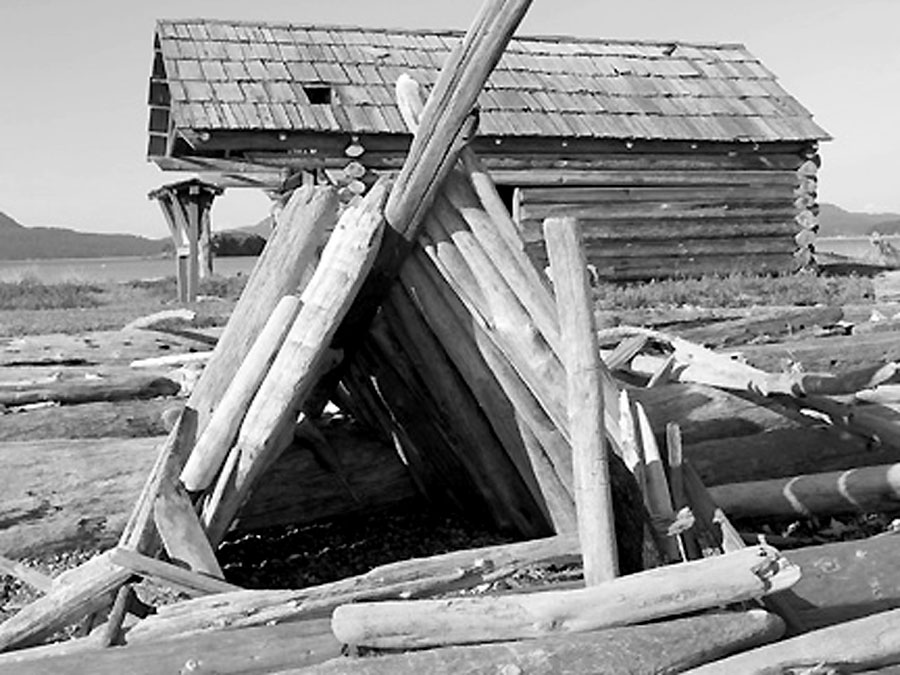
“My dear,” I replied with a Cheshire cat grin, cramming one last dry-bag into the milk-crate that served as my bike basket, “a sailor arrives neither late, nor early. He arrives precisely when he means to.”
“That,” my wife countered dryly, “is when a wizard arrives,” in reference to the Tolkien mania sweeping our household of late. “Sunday?” my wife repeated with a last affectionate hug.
Three hours later I was pressing five knots passing just east of Smith Island. Nais and I were half way across the Strait of San Juan De Fuca bound for the San Juan Islands.
Lunchtime found me drifting idly off of the southern side of Spencer Spit on Lopez Island. I love this narrow, little finger of sand and grass with its tumbled gray carpet of driftwood logs. The logs serve as a pallet for budding young artists. Each summer the shoreline undulates with massive, weather-beaten driftwood sculptures, some built tee-pee style, others in a log-cabin design. It’s always a fascinating display. It’s as if the spirits of that place fancy themselves as primordial art teachers. They lay out piles and piles of weathered, old logs just to see what the mortals will do. Inexorably drawn, humans meet the challenge: inevitably a gallery of antediluvian sculpture arises from the sand for us to admire.
Having perused this year’s shoreline offerings through my binoculars, it was time to move on. Trouble was, I hadn’t really decided where to go next. Prior to my departure, I had reluctantly accepted the fact that I would need to be highly selective about my destinations given such a short timeframe. In deference to this reality, I had plotted numerous possible routes, but had settled on none in particular. It was sort of like a pouting child being told that he would have to choose between licorice and a Tootsie-Pop. If I couldn’t have both, if I couldn’t go anywhere I wanted for as long as I liked, I would just hold my breath until my ears popped off, making no choice at all. But this wasn’t a candy store. I was on the ocean and the day was quickly passing. I would have to go somewhere for the night.
Privately, I longed to sail to fabled Sucia Island. I had gazed upon Sucia for the first time a year ago while standing high atop the summit of Mount Constitution on Orcas Island. In the lifting mists some two thousand feet below, Sucia, along with her two Spanish sisters, Patos, and Matia, sparkled in the distance like a string of emeralds at the base of the Strait of Georgia. I had been cautioned, however, by far more experienced salts than I that Sucia was “a bit of a stretch” for just a five-day journey. Stewart Island was more comfortably in reach, I was told. On these frigid, unforgiving waters caution seemed the better part of valor. I had set aside any real hope of reaching that sweet, Spanish isle this year. Even so, it seemed prudent to get as far north as possible on this day to preserve my options. So I set a course for Deer Harbor on the northwest side of Orcas Island. I reasoned that if nothing else, I would be deserving of a hot meal at the end of a long day.
Having cleared the rocks just north of Frost Island, I raised sail to catch the barest whispers of an afternoon breeze. Nais and I steered north for Harney Channel, the slender passage that separates Shaw Island from the immense western spur of Orcas Island to the north. Grateful at last to be rid of the numbing throb of my little four-stroke, I snaked quietly along the northern reaches of Shaw Island. Within an hour I experienced the first of what was apparently to become a fairly common occurrence for me as a novice single-hander: I couldn’t figure out where I was. Or more precisely, I didn’t believe that where I was was where I was supposed to be.
The splayed-out chart indicated that somewhere before me was Pole Pass, the narrow entrance to my day’s destination, Deer Harbor. But why was a gargantuan state ferry lumbering straight at me like a bull stampeding in slow motion? Surely the ferry didn’t run through the pass. No time to consider this more carefully for the moment. I dodged the imminent threat, then quickly doused sail so that I could give full concentration to matters of navigation. In a few moments the situation became more or less clear. I was on the verge of entering Wasp Passage to the south of Crane Island. Pole Pass was to the north. I fired up the Honda once again and crept along until I understood fully: Pole Pass wasn’t a pass at all, at least not to my way of thinking; it was just the narrowest crack of water between two threatening slabs of rock. I was slowly coming to terms with the fact that visual aids often weren’t. How in the world is one supposed to spot the sparest sliver of a passage in a seemingly unyielding landscape of rock, stone and tree? So you plot and chart and ghost along until at last, when your bow is all but on top of the rocks, things finally make some geologic sense. Trust to the compass and chart but slow as you go and keep a light finger on reverse.
I made my way cautiously through the minuscule, needle-like opening of Pole Pass, then on to Deer Harbor. Tied up snuggly in this large, comfortable marina, I took on fuel and considered my options. It was 4:30 in the afternoon, much too late to head any further north that day, particularly in unfamiliar waters. In the marina store where I was inquiring about moorage rates for the evening, a full-figured woman in a tight and very unflattering Hawaiian dress could be heard hollering disdainfully at her anguished husband. He was dressed in similar Hawaiian motif. “I said a frapuccino not a cappuccino,” the woman bellowed, stretching the gaudy red and yellow orchids printed across her ample bodice beyond all botanic plausibility. Moments later, fenders dangling, lines a-jumble across Nais’ cockpit, I was steaming out of Deer Harbor heading for a nearby piece of rock called Jones Island. Straightening up the disheveled cockpit, one hand loosely on the tiller, I gave only passing thought to the fact that even had my life depended upon it, I wouldn’t know the difference between a frapuccino and a cappuccino. I drink tea.
One hour later Nais slid into a quiet, tree-lined cove on the north end of Jones Island. It seemed a million miles away from the nearest espresso machine.
Jones Island is a little miracle of isolation. Just a few miles from the hurly-burly of neighboring Deer Harbor, the entire island is part of the Washington State Park system, all 188 acres. No snack bars, no fuel docks, no marina stores; just rock, tree and root.
I carefully nestled Nais into the last remaining space on the dock, grateful not to have to drop anchor in vain search for a grip on the cove’s reputed gravel floor. The water was mirror calm, reflecting an incandescent, silver-white glow as the last rays of light found their way through a thinning cloud cover. Looking aft from Nais’ cockpit I could see the formidable cliffs of Waldron Island immediately to the north. Slightly west and lower on the horizon, draped in the final crimson haze of twilight, there lay the Island of Saturna. Saturna is a long, spindly outcropping, the eastern most sentinel of the Canadian Gulf Islands. All in all, it was a splendid view off the stern of my little boat. Preparing for a night’s rest in the small but comfortable confines of Nais’ cabin, I made mental note to try a frapuccino when I got back home, maybe even pick up a Hawaiian shirt.
The second day of my meanderings began with a brisk hike around the entire perimeter of Jones Island. It was an exhilarating trek over forest and cliff, leaving me sweating and slightly short of breath. I returned panting to the boat with a disturbing suspicion that aging might, in fact, be inevitable. An hour later I was chasing a feeble breeze on the way to Stuart Island, five miles to the west. I had been advised that Stuart was a great kid destination. So a little reconnaissance work seemed in order for future family voyages. Successful kid adventures on the water I have learned require three essential elements: a minimum of sailing time, a maximum of romp time and ample food stores. The run between Jones and Stuart Islands would easily meet the first criteria.
Looking up from having poured a cup of tea, all my hopes for a smart crossing to Stuart Island were immediately dashed. Once again I had neglected to consider the formidable will of the currents. Unwittingly, my little sloop was slowly being swept into the mouth of San Juan Channel bound for Mexico or there abouts. The little kicker quickly sprang to life once again. Nais was now compelled to crab her way ignominiously into the shelter of New Channel, the eastern gateway to Stuart Island. Gratefully this quiet, narrow passage between Spieden Island to the south and Johns Island to the north turned out to be a wonderfully pleasant little journey. Harbor seals darted about the Nais like dark, glistening pearls with whiskers while jet-like cormorants swooped down and pierced water. The wildlife escorting me to Stuart Island may have been witness to better demonstrations of seamanship, but they kept their opinions to themselves.
Presently Nais entered the broad expanse of Stuart’s Reid Harbor. The sheer volume and size of this vast haven was breathtaking. More than half the length of the island itself, there was little by way of pleasure or working craft that could not take refuge here. But its very breadth left Nais and I feeling a little overwhelmed like a shy country boy on his first visit to the big city. We immediately turned tail, cutting through the rocky narrows of St. John’s Pass bound for Prevost Harbor to the north.
Nais settled gently against the wooden dock that appeared to grow right out of the forest at Prevost Harbor. The old sloop looked much more at home in these less conspicuous lodgings. The skies were again painted in a brilliant sapphire-blue, the hornets encouraged unseasonably to seek a morning meal in warmth of an Indian summer. Looking north across the calm of the bay, a short, rocky shoal interrupted the otherwise densely forested topography of Satellite Island. This had an effect of framing a far off view of Saturna Island in the deep greens of fir and cedar. On the dock I was handed a cold beer and warmly welcomed by several old salts that I had met the previous day at Jones Island. Two days, two islands. Not bad, so far. Not bad at all.
Stuart Island proved to be a fine destination for a rapid-fire run through the San Juans. My brief sojourn there included a grand five-mile hike to the stunning vista of the Canadian Gulf Islands off of Turn Point, gracious visits between neighboring wooden boats and a thoroughly sublime row through the winding nooks and crannies of Prevost Harbor’s northern shores.
But where to next? As welcoming as Stuart Island had been, it was time to move on. Having come to peace with a short-scripted voyage, I had nevertheless resolved to cram in as many ports of call as possible. So it was time to weigh anchor once again. Certainly Roche Harbor to the south was within easy reach and held the promise of a warm meal ashore, but Sucia still beckoned. The Spanish lady whispered hauntingly, dangling like a distant star at the edge of US waters some twelve miles to the north. The tide would turn shortly after midday. With any kind of a breeze I could still arrive there well before dark. It was now or never.
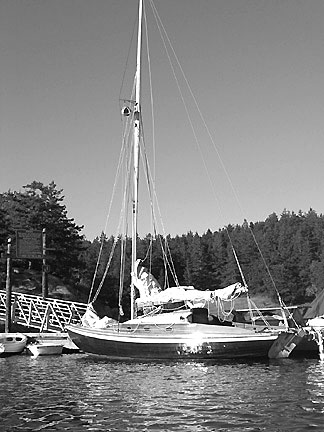
Literally throwing caution to the wind, I tacked out of Prevost Harbor on a freshening noon breeze. My luck held. I rode a brisk southerly up the eastern reaches of Boundary Pass all the way to the entrance to Sucia’s Fossil Bay. And there, drifting aimlessly toward the craggy entrance of this long, impressive inlet, I stood dumbstruck in the cockpit. I had screwed up the courage to travel to this distant star; I had planned and prepared for such a bold leap as if Nais were the HMS Beagle herself. But so apparently, had half the inhabitants of Bellingham! Only in that moment did the disquieting reality dawn on me: while Sucia Island seemed like the outermost reaches of the Milky Way from my vantage point in Port Townsend, for the good people of Bellingham, a journey to Sucia was no more than a run to the corner grocery. And seeing as it was Friday afternoon on the eve in what promised to be a deliciously warm weekend, anything and everything that floated and could hold a cooler had arrived at Fossil Bay long before me.
Hotdogs and salmon were already blackening on grills up and down the dock as I wearily nursed Nais into the last available piece of dockside real estate. A pleasant, evening breeze now wafted easily over the bay. An electric-gold sunset lit up the horizon, drawing a soft, yellowish cast on the boats moored offshore. Looking north across the narrow isthmus that separated Fossil Bay from the more diminutive Fox Cove, gently rocking masts pierced the dusk like the undulating spikes of a sea anemone. Despite the crowds, Sucia was truly a magical place. I was glad that I had come and readily understand why so many boaters wanted to visit here. Even so, as I lit the oil lamp and prepared for a night’s rest, I vowed never ever to return to Sucia Island on a weekend.
My heartbeat of a visit to Sucia ended with a seven o’clock ebb tide the following morning, the dawn of my fourth day out. Three islands down, one to go. It now was time to head south. I planned to ride favorable currents down President’s Channel. Then taking a hard left at Jones Island, I would sail down the broads of San Juan Channel bound for Fisherman’s Bay on Lopez Island. I chose Fisherman’s Bay for my final destination for several reasons. First, it seemed a good stepping-stone for the following day’s crossing of the Strait. Second, it had a restaurant called the Love Dog Café. By virtue of its name alone, The Love Dog warranted a visit. Finally, my guidebook to the San Juans read, “Many boaters bypass Fisherman’s Bay …they are apprehensive about the shallow entrance channel.” It sounded just perfect.
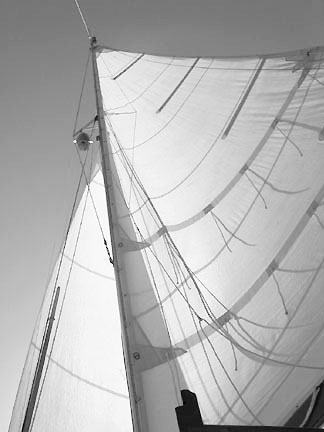
Eight knots? Couldn’t be. But that is precisely what the GPS indicated. Under my hand Nais had never before moved so sprightly, towing a dinghy no less. But there it was: close hauled, rails down, foam and spray slapping wildly across the bow, Nais raced southward like an old trail-horse storming towards home and a well-deserved oat bag. A quick tack to port at Jones Island and it was wing-on-wing nearly all the way to the entrance to Fisherman’s Bay. A brilliant autumn sun shone translucent through the sails.
“All the way to the entrance to Fisherman’s Bay,” I thought while lowering the sails. Right. The only problem was, where in the world was the entrance to Fisherman’s Bay? Once again, I found it impossible to believe the chart before me. Try as I might I just couldn’t accept the fact that there was an entrance anywhere along the now rapidly approaching shoreline. I could just envision Nais stuck high and dry on someone’s front yard on my last day at sea, a beach chair forlornly crushed beneath her bow. There were nothing but picket fences and café umbrellas growing out of the sandy shore in front of me, like the little paper umbrellas stuck in the fruit of exotic, mixed drinks. At last, having nearly turned back towards deeper water, I spied the inscrutably narrow channel that led to Fisherman’s Bay. Ghosting along, paying heed to the cautions of the guidebook, Nais and I were greeted to a friendly, expansive lagoon-like setting that lay at the foot of Lopez Village. I dropped a light hook in the glassy bay. Then after showering (bucketing would be more precise), I pulled on my last clean shirt and dinghied toward the dock in eager search of the Love Dog Café.
It had been a lovely stay at Fisherman’s Bay and Lopez Village. The steak and mushrooms at the Love Dog were grilled to perfection, the chocolate tort wickedly thick and rich. But it was time to head home. It was the morning of the fifth day. One last time, the fates had blessed me with clear skies and the promise of a warm weather. Nais’ sails would stay slung between the lazy jacks for now; there wasn’t a breath of wind anywhere. Motoring as quietly as the lumbering four-stroke would permit, I took my leave of Fisherman’s Bay. A nearby blue heron rose in the air, croaking irritably as if to say ‘good riddance’ for our having disturbed its early morning nap.
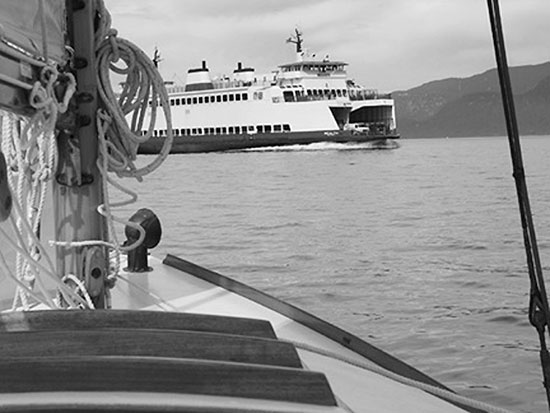
The lazy journey through Upright Channel to the north of Lopez Island, then back south through Thathcher Pass was uneventful. The sun rose in a blaze over the thick forests of Blakely Island to the east. Only a pair of powerboats thundering past disturbed the amber stillness of daybreak. Nais rocked sullenly in their wake. I growled a few surly epithets in return, something about hoping their waypoints pointed to Bolivia. Then all was quiet once more. Crossing Rosario Strait to the west of Burrows Island, I pointed Nais directly south for home.
There, is of course, something wholly spiritual and cosmic about being alone upon the water. It doesn’t matter whether it’s five months, five weeks or five days. It’s as if, at any moment in time, all the best energy of the universe converges on that sinuous sculpting of wood, bronze and canvas holding you suspended in watery space. And then there are the truly rare dispensations, the ones that feel as if a pompous collection of Greek gods clothed in sweeping robes with those goofy, gold wreaths on their foreheads were personally controlling each and every event on a huge, celestial map, just like the one in Jason And The Argonauts, and that at that particular moment, a short, balding god over in the corner notices your little boat alone upon the ocean and says, “Oh what the heck, why not?” Then as all the other more powerful gods bicker among themselves, moving pieces about the ethereal chessboard, pieces that affect wars, famine, pestilence and such, this one, short, balding god quietly moves a little, black and white figurine just in front of your boat and smiles.
I squinted in the bright glare of the noon sun while nearing the Partridge Bank buoy. Something was going on just ahead. It looked like a school of dolphin at first, the waters roiling and seething with activity. Then I saw it clearly: huge glistening, jet-black dorsal fins slicing the surface of the water like the conning towers of sleek submarines – Orca whales. Against all odds here was a pod of these mythical creatures to welcome me home. Not fifty yards before my starboard bow twelve or more of the massive animals breached and spouted and cavorted on their way back to the San Juans, apparently having stopped in Admiralty Inlet for lunch that day. I watched the frolicking pod like a kid watching his first fireworks display, dizzily trying to track every ember that peeled across the night sky, desperate not to miss a single moment of the supernatural event. I watched, suspended in time, until the leaping pod was just a series of black spots on the northern horizon. Finally, they were gone.
Back in the heavens, the short balding god moved the black and white figurine somewhere else on the cloud-rimmed map. Raising a cupped hand to cover his grin, he snickered to himself: the battery in my digital camera, as he well knew, had long been spent on prosaic photos of seals and sunsets. This moment was to remain forever mine and mine alone.
Awaking from the trance, I felt the puffs of a building afternoon breeze. Raising sail, I tacked toward Point Wilson. It was Sunday; Deborah and the kids would be waiting

